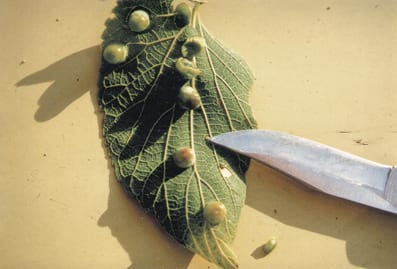(Including Hackberry Psyllid, see also Lerp Psyllids see)
Gall-making: Pachypsylla spp. (psyllid), P. celtidismamma (nipple gall maker).
Non Gall-making have many species.
There eggs are very small, shape and color vary with species. and nymphs have Piercing/sucking mouth parts, color varies. The adults are both sexes winged, hind legs made for jumping, like a tiny cicada (similar to tiny cicada).
Psyllids have many host plants located throughout the United States
Rapidly growing young foliage seem to be the attractant.
For the Gall-makers, Galls produced on buds, leaves and twigs. On hackberry, both blister and nipple galls are small (1/8 inch) and raised 1/2 inch above the leaf surface. Nipple galls can cause premature leaf drop and for the Non Gall-makers: leaf cupping, honey dew and sooty mold occur.
Gall-makers overwinter as adults in crevices or rough bark, or inside houses. One generation each year with mating and egg-laying for a few weeks when new leaves unfold. Eggs hatch within 7-10 days, and nymphs begin to feed on leaves. At each site a cup or gall of plant growth envelop nymphs. There they live throughout the summer, emerging as adults in late summer. Bud gall psyllid adults emerge from galls on leaf buds in late spring. Eggs are laid on leaves and newly-hatched nymphs feed on new buds, where galls are formed. Nymphs reach fifth instar by fall and remain in galls until spring.
Non Gall-makers over winter on twigs as nymphs and develop on expanding leaves. Adults appear in late spring and lay eggs in early summer. Adults of some species may survive overwinter.


